Gulls, gulls, gulls. Yesterday evening was an indulgence of mine, though many would consider it a penance. A friend organises an annual gull-count on the Exe, which attempts to keep tabs on the number of gulls using the river as a roost - they're not monitored in any other meaningful fashion here, unlike some other wetlands where the BTO's Wetland Bird Survey volunteers note the numbers each month. To be fair, the number of gulls present on the river in the daytime is a shadow of the numbers roosting overnight, so the WeBS counts would not be particularly representative. Anyhow, three of us gathered at the Topsham recreation ground to count the birds moving south down the river.
 |
| This is the gull-count view. Birds tend to mass over and behind the bridge in the background, before moving down the river at anything between 1 and 100m height. |
The gulls tend to come downriver in a particular pattern. First of all, there are always a couple of hundred birds loafing around the river when we arrive; mainly Black-headed Gulls, with a smattering of Common and Herring Gulls here and there and perhaps the occasional Great Black-back. Looking upriver past the M5 road bridge which spans the floodplain, you can see a gathering mass of Black-headed Gulls floating and swirling around the Countess Wear sewage works. The first flocks of Black-headeds start to make their way purposefully down past us, initially twenties and thirties, but soon building to a constant stream of birds. The first birds come through low down, perhaps 10-20m above the water, but the bulk of them drop down from somewhere above 100m height, slight black silhouettes against the evening's grey skies. Common Gulls are sprinkled sparingly throughout the flocks; it's tricky, but feasible, to pick out their slightly more rakish shape amongst the Black-headeds which are by now sleeting past us.
Eventually the Herring Gulls put in an appearance. At first just singles and twos amidst the smaller gulls, soon they are the bulk of the flight, many of them dropping down from even higher than the Black-headed Gulls. The numbers of Black-headed and Common Gulls dries up rapidly, leaving us with a stream of Herring Gulls floating down in gathering darkness until they too peter out. A last quarter hour of patience is rewarded with a late flock of about a hundred Black-headed Gulls suddenly hurtling past, bellies almost touching the water, and a couple of groups of Herring Gulls, necks stretched and calling as they sail past.
 |
| Spot the Common Gull. |
So, limbs numbed with the lack of movement in a biting northwesterly wind, and brains slightly numbed with counting gulls past in fifteen-minute blocks, we end up with a total count that is - once again - slightly lower than the previous year. One day we'll perhaps be able to find out why the number of gulls roosting on the river is dropping, but for now we're happy to guess that it might be a combination of climatic changes across Europe, population declines of some species (especially Herring Gulls) and/or changes in food supply and availability in the catchment of the Exe.
 |
| Either the sun just came through below the cloud, or Haldon Forest has just been taken out with a tactical nuke. I favour the former personally, as though it does make counting tricky for a while, at least it means dinner will still happen. |
Today (Sunday), for variety's sake we took a pleasant mid-day walk down the river Otter; Na, Sabina and myself. We started out from Budleigh Salterton and wandered upriver to the footbridge across the river, then back down the eastern bank. Despite the continued presence of the same stiff north-west wind as yesterday's gull count, the weather was pleasant enough to find an increasing presence of spring flowers: hazel catkins are out in some numbers - yellow tassels bobbing and flapping in the wind, spreading pollen on the air; Red Campion and Herb-robert shining pink-red from the longer vegetation on the side of the path; Hogweed and Cow-parsley taller still with white umbels swaying in the gusts; and a small patch of White Deadnettle by the river, with their hooded creamy-white flowers looking richly succulent amongst a spray of vivid green leaves.
 |
| White Deadnettle |
The rivermouth was alive with gulls (sorry!) using the fresh water of the ebbing tide to bathe and drink. The vast majority were Herring and Black-headed Gulls, with a trio of Great Black-backed Gulls hulking in the middle and a solitary Common Gull floating serenely downriver on the breeze. Further upriver, whilst Sabina settled into her lunch, a Dipper was peacefully hunting the edge of the water, ducking into the water and pulling out what looked like water-snails, then calmly battering them on a handy rock before swallowing them. We ended the walk - throughout which Sabina remained resolutely asleep - with a coffee on the beach, relaxing out of the wind in the afternoon sunshine. Couldn't really be much better than this, I guess...
 |
| Sabina relaxes and blows some bubbles after a tiring day being carried around in her sling. |
 |
| The afternoon sunshine, looking westwards along the coast towards Ladram Bay. |









No comments:
Post a Comment